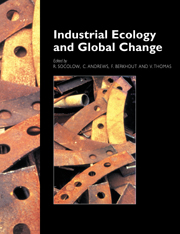Book contents
- Frontmatter
- Contents
- Foreword
- Preface
- Acknowledgments
- Contributors
- OVERVIEW
- PART 1 VULNERABILITY AND ADAPTATION
- PART 2 THE GRAND CYCLES: DISRUPTION AND REPAIR
- PART 3 TOXICS AND THE ENVIRONMENT
- 15 Introduction
- 16 Soil as a Vulnerable Environmental System
- 17 The Vulnerability of Biotic Diversity
- 18 Global Ecotoxicology: Management and Science
- 19 Industrial Activity and Metals Emissions
- 20 Metals Loading of the Environment: Cadmium in the Rhine Basin
- 21 Emissions and Exposure to Metals: Cadmium and Lead
- 22 Nuclear Power: An Industrial Ecology that Failed?
- PART 4 INDUSTRIAL ECOLOGY IN FIRMS
- PART 5 INDUSTRIAL ECOLOGY IN POLICY-MAKING
- END PIECE
- Organizing Committee Members
- Working Groups
- Index
20 - Metals Loading of the Environment: Cadmium in the Rhine Basin
Published online by Cambridge University Press: 04 August 2010
- Frontmatter
- Contents
- Foreword
- Preface
- Acknowledgments
- Contributors
- OVERVIEW
- PART 1 VULNERABILITY AND ADAPTATION
- PART 2 THE GRAND CYCLES: DISRUPTION AND REPAIR
- PART 3 TOXICS AND THE ENVIRONMENT
- 15 Introduction
- 16 Soil as a Vulnerable Environmental System
- 17 The Vulnerability of Biotic Diversity
- 18 Global Ecotoxicology: Management and Science
- 19 Industrial Activity and Metals Emissions
- 20 Metals Loading of the Environment: Cadmium in the Rhine Basin
- 21 Emissions and Exposure to Metals: Cadmium and Lead
- 22 Nuclear Power: An Industrial Ecology that Failed?
- PART 4 INDUSTRIAL ECOLOGY IN FIRMS
- PART 5 INDUSTRIAL ECOLOGY IN POLICY-MAKING
- END PIECE
- Organizing Committee Members
- Working Groups
- Index
Summary
Abstract
Air emissions of cadmium in the Rhine Basin are estimated for the years 1955 to 1988. Sources include iron and steel production, coal and oil combustion, nonferrous metal production, cement manufacturing, and solid waste incineration. Emissions have decreased by an order of magnitude since the 1950s. Cadmium in solid wastes are also estimated to have decreased, by about a factor of two. Aqueous emissions have decreased by an order of magnitude, with about one-half of the remaining emissions from nonpoint sources, such as urban and agricultural runoff. The topsoil cadmium concentration is estimated to have increased by about 10% between the mid-1970s and the late 1980s. Assuming that the soil pH is maintained in agricultural soils, cadmium intake is estimated to remain below World Health Organization recommended thresholds for many decades.
Introduction
The Rhine Basin encompasses most of Switzerland, southwestern Germany, northeastern France, Luxembourg, and most of the Netherlands. Its total area, about 200,000 km2, is about the size of the state of Georgia, with a current population of approximately 50 million. It has been one of the most industrialized and polluted river basins in the world for many decades. Beginning in the early to mid-1970s, however, there has been a marked decrease in pollution for most chemicals, even though the level of industrial activity has not declined appreciably since that time. Thus, the cleanup of the basin may be considered a success story which hopefully may be emulated in river basins still trapped in the production-pollution syndrome.
- Type
- Chapter
- Information
- Industrial Ecology and Global Change , pp. 287 - 296Publisher: Cambridge University PressPrint publication year: 1994
- 5
- Cited by



